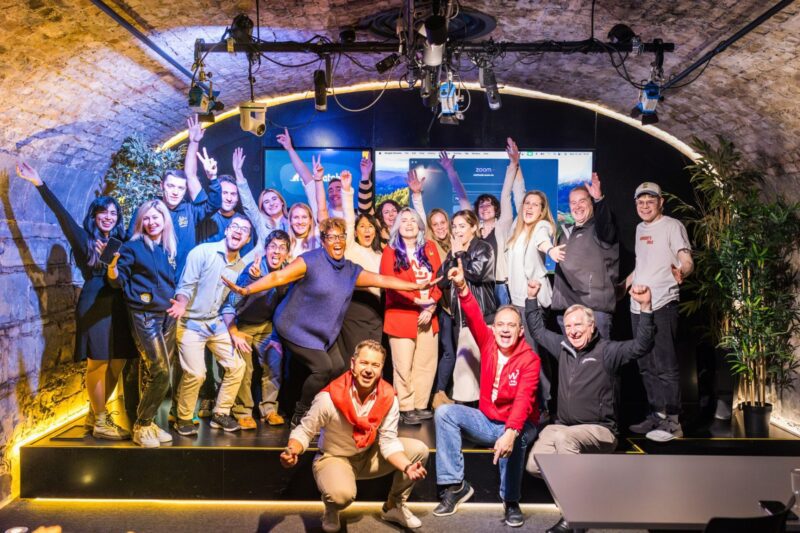Remote collaboration: How to feel more connected in a disconnected world

This past year, almost every company became remote-first, and many leading (tech) companies announced that remote-first will stay the default. How can startups continue to thrive in this remote-first world and ensure that they get the best results out of distributed collaboration?
To address this, we need to be clear on the differences between communication and collaboration. Communication is simply exchanging information, where collaboration requires people to join to create or accomplish something. Collaboration requires clear communication, but this does not mean that collaboration and communication are the same. Communication is the sharing of information, and collaboration relies on using that information to reach a specific outcome.
Let’s dive into what a startup can do to optimize its collaboration.
Start with your culture
The culture you cultivate dictates how your company collaborates. Your culture decides who you hire, your desired communication style, expected behavior, etc. In addition, we live in unprecedented times. When everything changes very quickly, the company grows or shrinks, and there is a lot of uncertainty; culture is the one thing that allows everyone to be sure that the right decisions get made.
Every startup culture is different. However, if you strive for great remote collaboration, there is one requirement: “psychological safety.”
Psychological safety: The experience of whether or not people feel that they can speak up, ask for help, and offer an idea. In other words, it’s the belief that you won’t face the consequences if you make a mistake. When people can be themselves, they can do their best work. Without having this space to be yourself, it’s impossible to form a team. For a startup to survive, it’s necessary to be creative, assertive, and (sometimes) daring. This is only possible when you create this physiological safety.
Once you establish your startup’s cultural foundation, you can focus on ways to improve remote collaboration.
Prioritize meaningful work
“Zoom fatigue” is real. When working from home, the number of video calls significantly increases, and hopping from call to call is draining. We have less energy and time for the deep work that makes the difference. To overcome this challenge, we need to evaluate how we spend our time based upon output and not presence. Did you know that the most productive people have children? That’s because they don’t have time to fool around, and they have another person for whom they are responsible. We can’t force our employees to have more children; nevertheless, we can learn that being less online makes you more productive.
You can prioritize meaningful work by blocking off one or two meeting-free days. Blocking this time ensures that you can work on critical projects that move the company forward, and the feeling of meaningfully contributing increases job satisfaction.
Build trust
We tend to trust the people we engage socially with the most; therefore, we must regularly interact informally with our teammates. It is crucial that leadership does not impose a particular form of communication and collaboration on teams but lets them decide what works best. Here are some “meeting” ideas to try that don’t include talking about work:
- Camera-free 1:1s where you chat while you walk
- Weekly virtual team coffee meetings
- Monthly meetings where you focus on the personal development of your team. You will need to create a safe place where there is room for vulnerability.
Synchronous versus asynchronous work
It wasn’t long ago that most workplaces required that employees communicate and respond in real-time. Studies show that this approach is not very practical. Perhaps it sounds counterintuitive since digital communication means that you’re always available to address issues immediately. However, in practice, we see that frequent interruptions affect our productivity. This ties back to prioritizing meaningful work: When I am constantly interrupted, I won’t focus on the work that really makes a difference. Asynchronous work gives me control over my day.
There are many more advantages of working asynchronously:
- Time zone flexibility. You can work when it’s most convenient for you.
- High-quality information. You can have more time to think through a particular problem/idea, and you can give it more brainpower.
- Better communication. More precise and thorough communication helps you avoid unnecessary back-and-forths. This implies that every remote worker is adept at written communication.
A successful remote company prioritizes asynchronous work. However, we still need synchronous communication for:
- Team/trust-building. Building rapport just works better in real-time.
- Crisis communication. If shit hits the fan, you need to be able to react immediately.
- Discussing sensitive information. When you give personal feedback, it’s better to look someone in the eye.
- New projects. When introducing a new project, you want to get people up to speed quickly.
Review how you communicate and collaborate
Regularly ask your team for feedback on whether your communication and collaboration processes are working for them. Set up monthly pulses with questions and make sure that people can answer anonymously. By frequently asking for feedback, you make sure that you get buy-in from the team and keep them engaged. Perhaps even more important, you can continue to improve your communication and collaboration processes.
Be mindful of the introverts
Some colleagues are natural self-promoters, easily leading the group discussions and clearly articulating what they’re working on. For introverts, it can be a big challenge to promote their work. It’s therefore essential to democratize the group meetings and give everyone a chance to speak up. An easy way to do this is to work with a timer and give everyone a set time to share.
Meet in person when possible
Research shows that for adults, it takes about 50 hours of interaction to become casual friends. Ideally, you’d like to have your colleagues become friends. This improves the culture, creates more psychological safety, and improves productivity (people who like each other work harder for each other). However, making friendships while working remotely is just more complex and will take way more than 50 hours. Therefore, try to meet in person when possible. When you live in the same city, you can easily set up walking meetings. If this isn’t possible, try to organize offsite meetings where the team can really connect.
Get the right tools
“Give me six hours to chop down a tree, and I will spend the first four sharpening the ax.”
This quote by Abraham Lincoln teaches us that it’s essential to have the right tools to achieve your goals. Take a look at this list of remote tools and find out what works well for your organization. I use Slack, Notion, G-Suite, Zoom, and of course, Miro. Miro is an excellent tool for synchronous and asynchronous collaboration. And it helps your startup to scale: You can discover and validate your ideas, design products, apply product frameworks, and way more. Quickly brainstorm live during a Zoom call, work asynchronously on your new product, and tag someone to get feedback on your work. We are giving away a $1000 Miro credit for early-stage startups. Click that link to get started.
I’d love to learn about your remote collaboration experience. And as always, feel free to reach out with any questions!

About the author:

Jaïr Halevi is a Startup Program Manager at Miro, collaborative whiteboarding solution. He’s building and growing all range of strategic brand programs for Education, Non-profits and Startups.
If you are interested to find out more about Miro, reach out to him: jair@miro.com


